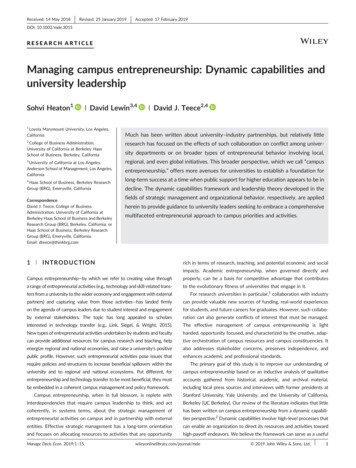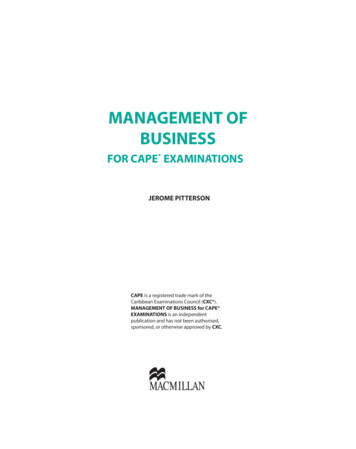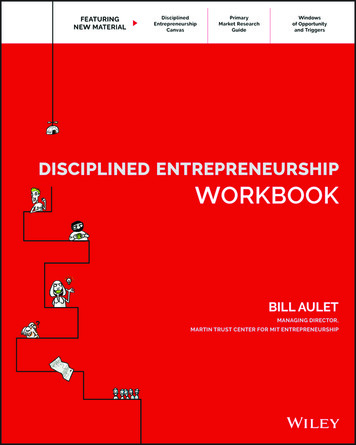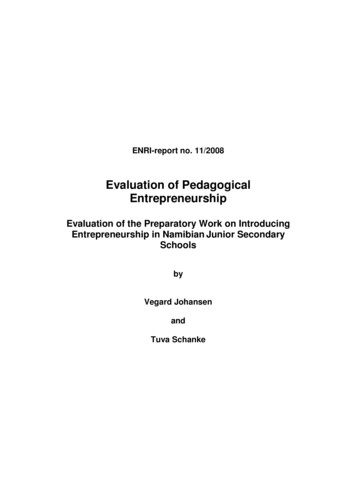
Transcription
Received: 14 May 2018Revised: 25 January 2019Accepted: 17 February 2019DOI: 10.1002/mde.3015RESEARCH ARTICLEManaging campus entrepreneurship: Dynamic capabilities anduniversity leadershipSohvi Heaton1 David Lewin3,4 David J. Teece2,41Loyola Marymount University, Los Angeles,California2College of Business Administration,University of California at Berkeley HaasSchool of Business, Berkeley, CaliforniaMuch has been written about university–industry partnerships, but relatively littleresearch has focused on the effects of such collaboration on conflict among university departments or on broader types of entrepreneurial behavior involving local,3regional, and even global initiatives. This broader perspective, which we call “campus4long‐term success at a time when public support for higher education appears to be inUniversity of California at Los Angeles,Anderson School of Management, Los Angeles,CaliforniaHaas School of Business, Berkeley ResearchGroup (BRG), Emeryville, CaliforniaCorrespondenceDavid J. Teece, College of BusinessAdministration, University of California atBerkeley Haas School of Business and BerkeleyResearch Group (BRG), Berkeley, California; orHaas School of Business, Berkeley ResearchGroup (BRG), Emeryville, California.Email: dteece@thinkbrg.com1 entrepreneurship,” offers more avenues for universities to establish a foundation fordecline. The dynamic capabilities framework and leadership theory developed in thefields of strategic management and organizational behavior, respectively, are appliedherein to provide guidance to university leaders seeking to embrace a comprehensivemultifaceted entrepreneurial approach to campus priorities and activities.I N T RO D U CT I O Nrich in terms of research, teaching, and potential economic and socialimpacts. Academic entrepreneurship, when governed directly andCampus entrepreneurship—by which we refer to creating value throughproperly, can be a basis for competitive advantage that contributesa range of entrepreneurial activities (e.g., technology and skill‐related trans-to the evolutionary fitness of universities that engage in it.fers from a university to the wider economy and engagement with externalFor research universities in particular,1 collaboration with industrypartners) and capturing value from those activities—has landed firmlycan provide valuable new sources of funding, real‐world experienceson the agenda of campus leaders due to student interest and engagementfor students, and future careers for graduates. However, such collabo-by external stakeholders. The topic has long appealed to scholarsration can also generate conflicts of interest that must be managed.interested in technology transfer (e.g., Link, Siegel, & Wright, 2015).The effective management of campus entrepreneurship is lightNew types of entrepreneurial activities undertaken by students and facultyhanded, opportunity focused, and characterized by the creative, adap-can provide additional resources for campus research and teaching, helptive orchestration of campus resources and campus constituencies. Itenergize regional and national economies, and raise a university's positivealso addresses stakeholder concerns, preserves independence, andpublic profile. However, such entrepreneurial activities pose issues thatenhances academic and professional standards.require policies and structures to increase beneficial spillovers within theThe primary goal of this study is to improve our understanding ofuniversity and to regional and national ecosystems. Put different, forcampus entrepreneurship based on an inductive analysis of qualitativeentrepreneurship and technology transfer to be most beneficial, they mustaccounts gathered from historical, academic, and archival material,be embedded in a coherent campus management and policy framework.including local press sources and interviews with former presidents atCampus entrepreneurship, when in full blossom, is replete withStanford University, Yale University, and the University of California,interdependencies that require campus leadership to think, and actBerkeley (UC Berkeley). Our review of the literature indicates that littlecoherently, in systems terms, about the strategic management ofhas been written on campus entrepreneurship from a dynamic capabili-entrepreneurial activities on campus and in partnership with externalties perspective.2 Dynamic capabilities involve high‐level processes thatentities. Effective strategic management has a long‐term orientationcan enable an organization to direct its resources and activities towardand focuses on allocating resources to activities that are opportunityhigh‐payoff endeavors. We believe the framework can serve as a usefulManage Decis Econ. 2019;1–15.wileyonlinelibrary.com/journal/mde 2019 John Wiley & Sons, Ltd.1
2HEATONET AL.tool to help guide campus entrepreneurship. The strategic managementWashburn, 2005). Others provide more optimistic views, however,of universities is at an early stage of development; hence, there is muchincluding that there are synergetic effects when academic and indus-to be learned by identifying causal factors influencing the relationshiptry researchers collaborate because they generate new knowledgebetween campus entrepreneurship and university performance.from applied science (Shane, 2004).To achieve this objective, we take a holistic approach to campusAs we discuss more fully in the sections that follow, we believeentrepreneurship that goes beyond well‐documented examples ofthese studies capture only one aspect of creating an entrepreneurialtechnology transfer and startup launch pads. We first survey the tradi-campus. The basic problem is that, by and large, these studies are nar-tional academic entrepreneurship literature and then describe in morerowly focused on technology transfer as the key engagement mecha-detail contemporary academic entrepreneurship. We then proposenism of the university with the commercial world. This focus overlooksand describe a dynamic capabilities approach to campus entrepreneur-other important considerations. In particular, success in academicship. Finally, we develop a set of propositions drawn from thisentrepreneurship involves many processes and strategies by whichapproach to guide future empirical research on this topic.participants in the campus ecosystem enhance the utility of inventions, which is not limited to commercialization activities. For example,Cyert and Goodman (1997) point out that university–industry alli-2TRADITIONAL CAMPUSE N T R E P R EN E U R S H I P ances constitute an opportunity for learning rather than merely fortechnology transfer. In our view, this particular opportunity can andshould be examined at multiple levels.Historically, much attention paid to academic entrepreneurship hasfocused on research partnerships and the commercialization of technology through patent licensing and technology transfer, typicallymanaged through a university's technology licensing office. Suchresearch highlights different factors and makes various argumentsabout why one or another factor is important in explaining strong or3 C O NT E M P O R A R Y A C A DE M I CE NT R EP RE NE URSHIP' S EC ONOMIC ANDSOCIAL IMPACTSweak performance in university technology transfer.Studies include those on the impact of the involvement of star scientists (Zucker, Darby, & Brewer, 1998), inventors (Jensen & Thursby,3.1 Campus entrepreneurship and urbandevelopment2001), and academic entrepreneurs (Louis, Blumenthal, Gluck, & Stoto,1989) on successful transfer. A significant literature also exists thatMany academic leaders have come to understand that the modernexplores the effectiveness of different modes of technology transfer,university is no longer just an institution of higher learning, research,such as patenting, licensing, startup creation, and university–industryand reflection. Instead, universities are or can be the core of an inno-partnership (see Lockett, Siegel, Wright, & Ensley, 2005, for reviews).vation ecosystem that includes other public and private actors. Uni-Much of the existing research has highlighted the role of the technologyversities that fail to create and nurture such ecosystems risk limitinglicensing office as a crucial factor in licensing success (Siegel, Waldman,their larger impacts and may thereby starve themselves of theAtwater, & Link, 2000). Other mechanisms of technology transferresources necessary for their long‐run survival.include informal channels such as staff exchange and joint publicationsUniversities can have impacts at—and must be conscious of—the(Link, Siegel, & Bozeman, 2007). Such informal interaction with univer-global, national, regional, and local levels. The most direct and immedi-sity researchers was found to be of more importance for licensing suc-ate impact is at the local level. Universities are often among the largestcess than formal mechanisms, such as patents and licenses (Mowery &landowners and employers in their cities, which gives them a centralSampat, 2005). Similarly, Agrawall and Henderson (2002) conclude thatposition in the local economy. Moreover, the health and viability ofopen channels, such as publications and conferences, are the main path-the surrounding locale can serve as a significant deterrent to or drivingways through which industry most benefits from academic research.force for the growth of a university. Yet, too often, a university fails toThese studies highlight significant mechanisms for the entrepreneurialmake a concerted effort to engage with its local community. This isand revenue‐generating activities of a university.not just about receiving or investing money; it is often more aboutAn implication of these studies is that universities are now morehelping to orchestrate and nurture relationships with local partners.highly motivated to succeed in both academic and commercialA notable example of positive local community engagement is thespheres. However, this view has not been universally embraced.3revitalization work done by the University of Pennsylvania (Penn), anMany have expressed concerns that heightened entrepreneurial activ-“Ivy League” private university located in Philadelphia.4 As Penn deep-ities have a corroding influence on traditional university roles ofened its strength as a top research university, the West Philadelphiaresearch and teaching (Ambos, Makela, Birkinshaw, & D'Este, 2008).neighborhood it occupied remained economically depressed, sufferingAdvocates of this view fear that the further engagement of the univer-from high crime, a deteriorating housing stock, and failing schools. Thesity in society will dampen its spirit of creative and critical inquiry.university was aware of the threat that this situation posed to itsSome argue that a concentrated focus on applied science will drawfuture viability, but for years, local initiatives intended to deal with thisuniversities away from basic research (Dasgupta & David, 1994;matter were pursued piecemeal.
HEATON3ET AL.In 1994, Judith Rodin became the university's president. SheFurther in this regard, Niccum, Sarker, Wolf, and Trowbridgeunderstood that Penn had to provide a safe and vibrant physical envi-(2017) analyzed 13 medical school curricula and over the studyronment conducive to creativity and innovation in order to attract stu-period found a notable increase in innovation and entrepreneurshipdents, faculty, and industry. She led a coordinated, integrated urbanprograms and courses. Similarly, Bloom (1988) observed new formsrenewal approach covering housing, retail trade, and K‐12 educationof research entrepreneurship in medical schools, with corporations(Rodin, 2004). Penn officials collaborated with community membersproviding funding for research related to drug discovery and collab-to devise strategies for financing neighborhood initiatives. The univer-oration in the delivery of hospital and ambulatory care.sity mobilized intellectual and financial support for the plan, whichOne approach to facilitating faculty entrepreneurship is to providerequired both internal and external transformation. Rodin reports,faculty flexibility around leaves of absence. As former Stanford Uni-“[W]e had to reorient our administrative culture to work holisticallyversity President John Hennessy explained, “We've tried to say to fac-toward simultaneously transforming the university and the neighbor-ulty members, you want to go start something, fine, you go off andhood” (Rodin, 2007, p. 46).start. When you're ready to come back, you come back. But sittingThe result has been a virtuous circle. The urban renewal it sparkedhere with your mind down there doesn't work.”5provided a better environment for stakeholders. New businessesIn yet another example, college and university athletic departmentssprung up and created new jobs and a higher tax base, which helpedhave a long history of helping build brand image and alumni loyaltyfund better local services. Today, the surrounding area is a recognizedand have often used entrepreneurial methods to do so. Some collegesinnovation hub, with Penn and Drexel University as anchor institu-and universities offer athletic stadium space for multiple uses, such astions. From 2004 to 2010, the share of graduates of these institutionstrade shows and special events, which can also create strong links to awho were not Philadelphia natives and who chose to remain in theuniversity's surrounding community and generate revenue from suchregion rose from 29% to 48% (Campus Philly, 2011).uses. To illustrate, California State University, Los Angeles' 125‐acreRecognizing that university entrepreneurship is important leadsmultiuse facility yields about 200,000 in annual revenue from sport-one to pay attention to broader ecosystems such as the local ecosys-ing event ticket sales (Alstete, 2014, p. 82).6 Other nonacademictem. The activities and interactions that produce long‐term value candepartments can also benefit from enhanced entrepreneurial initia-occur anywhere in the university's ecosystem. Successful ecosystemtives. For example, the University of Arizona libraries pursued increasenurturing depends not only on the institution but also on the capabil-revenues from nonacademic sources, such as cafes and partnershipsities and involvement of individual university faculty and leaders. Fac-with athletic departments, to offset persistent funding shortagesulty members often engage in boundary‐spanning activities that allow(Cuiller & Stoffle, 2012).them to identify opportunities for the university to help shape out-In this vein, Etzkowitz (2013) argues that auxiliary commercial andcomes. Whereas some university leaders, such as Rodin, will rise tocultural activities can be created from any form of knowledge—literarythe demands of ecosystem development based on their own inclina-and scientific—and shows how a drama teacher at Southern Oregontion and experience, others will need explicit guidance and support.School of Education (later renamed Southern Oregon State College)The Penn example is not unique. Yale, for example, has had some suc-in Ashland, Oregon, initiated a Shakespeare Festival during thecess with efforts at turning around socioeconomic decline in New1930s Depression, providing a student training ground that supportedHaven, Connecticut (Stannard, 2018).development of a nationally renowned theater school that is stillvibrant today. This helped develop an arts cluster with ancillary touristfacilities, which made it possible to reconceptualize Ashland as a noted3.2 Entrepreneurship activity among variousdisciplineshumanities city rather than a traditional natural resource‐based (i.e.,wood products) city.This is not to say that the university should favor commercial andEntrepreneurship has taken root in many corners of the universityentrepreneurial values over research, instruction, and professionalbeyond science departments and engineering, business, and medicalactivity. The two are complements, not substitutes. The evidence sug-schools. Social sciences and humanities departments have also foundgests, for example, that faculty who are excellent in outreach andeducational and economic value in becoming more enterprising andexternal (entrepreneurial) engagement are also likely to be betterengaged in professional training and policy‐related analysis andresearchers (Lowe & Gonzalez‐Brambila, 2007; Zucker & Darby,research sponsored by the private sector and federal and state2007). Faculty entrepreneurs are among the most productive andagencies (Clark, 2000, p. 17). Additionally, consulting work that isbest cited in their respective fields, even after they form startup com-usually done by faculty outside of their university responsibilitiespanies. In fact, a recent study (see Table 1) showed that, in general,isandcampus entrepreneurs are more productive than peers in terms ofdepartments, at least in the United States. A survey of faculty inannual research papers. This was found to be true for biology,U.S. colleges and universities found that about half of fine artsmechanical engineering, materials, electrical and computer engineer-faculty were engaged in outside work—about the same as for engi-ing, and medicine, but not chemistry (Lowe & Gonzalez‐Brambila,neering faculty—as were about 25% of humanities faculty (Lee &2007, p. 186). An additional finding of great interest is that facultyRhoads, 2004, p. 748).entrepreneurs experience an increase in annual publications nes
4HEATONTABLE 1ET AL.Entrepreneurs' average annual publications: 5 years before and after founded a 63.863.66Mechanical Engineering110.530.61Materials and 25SignificantHa: mean (diff) 0***Full hemistry135.224.726.466.381.24*Note. ECE: electrical and computer engineering; SD: standard deviation. Source: Lowe & Gonzalez‐Brambila, 2007, p. 184.*Significant at 10%.**Significant at 5%.***Significant at 1%.and after starting a firm. This is particularly pronounced for engineer-revenue sources. Some universities have focused on attracting full‐ing faculty (Lowe & Gonzalez‐Brambila, 2007, p. 186) and holds nottuition‐paying foreign students. Other revenue sources that arejust in absolute terms but also relative to coauthors and peers.aggressively pursued by universities include grants from and/or part-Table 1 makes a compelling case for the complementarity of entre-nerships with companies, local governments, philanthropic founda-preneurship and research output across multiple scientific fields.tions, income from campus‐provided services, and fundraising fromalumni. As such activities have expanded in the United States, distinctions between for‐profit, private nonprofit, and public universities3.3 Campus entrepreneurship and campusfundraisinghave become blurred (Riedel, 2013).Further, universities increasingly find themselves competing forthe same funding sources as well as for students, faculty, and positionsUltimately, academic entrepreneurship aims to expand campus busi-in “league tables.” That is, regional, national, and global rankings ofness models beyond teaching and research so that a university canhigher education institutions provided by numerous sources, such asbetter accomplish its core functions. In some cases, this may involvethe US News' university rankings and the Financial Times businessdirectly seeking new funds through partnerships with off‐campusschool rankings, have become increasingly important to success inorganizations. In other cases, it may be a matter of raising arecruiting top students and faculty.university's profile and/or building its brand to attract more fundsThe dramatic decline in state‐provided financial support during thefrom governments, businesses, and alumni, including alumni who have21st century has been especially pronounced in California, which infounded startup businesses with the assistance, both financial andturn has amplified the need for new sources of revenues for its publicnonfinancial, of the universities from which they graduated.universities, including UC Berkeley and the University of California,It is readily evident that in recent years the funding of higher edu-Los Angeles. These institutions are now very active in fundraising, ascation has become a prominent concern, especially for public universi-evidenced by the growth of their centralized and decentralized—ties in North America and the United Kingdom. Some universities areschool and department—development offices and the staffing of suchcoping with relatively flat or declining enrollments, which had previ-offices. This experience has been replicated in most other U.S. statesously increased about 2% annually from 2007 to 2015 (Ernst & Young,with respect to their public universities (Gardner, 2017; Yang, 2011).2017). During the same period, average annual marketing cost perIt is therefore not surprising that a 2011 survey found that presidentsenrolled student in private colleges and universities increased byof public universities spent an average of 6.7 days per month onabout 3,300, or more than 50%, reflecting heightened competitionfundraising and that most of these presidents considered fundraisingfor students. Since then, higher education costs have continued toto be among their top three job duties (Jackson, 2013).rise. In the United States, competition among universities is evenOne of the more visible manifestations of enhanced fundraisingkeener than before, yet elements of the public have become skepticalefforts is that wealthy donors have increasingly been receiving creditof the value of a university degree. With less public funding available,for gifts by having university facilities and schools and research cen-both public and private universities have been forced to diversify theirters named after them. To illustrate, the number of medical schools
HEATON5ET AL.named after donors increased from 15 to 26 during the last twofrom alumni. By contrast, a broader, deeper university entrepreneur-decades (Bailey, 2016). In other examples, in 2015, Harvard renamedship perspective expands this horizon to include the potential forits public health school the T.H. Chan School of Public Health in returnsupporting the growth of regional and national economies, bringingfor this billionaire's record‐setting 350 million gift; in 2017, the Uni-together talent from a range of disciplines in order to develop innova-versity of Chicago's economics department was renamed the Kennethtive ideas that address practical problems, and building a network ofC. Griffin Department of Economics in recognition of a 125 millionsuccessful alumni and industry partners that will themselves prospergift from a hedge‐fund magnate; in 2010, University of California,and be better able and willing to financially support the university.Los Angeles, renamed its medical school the David W. Geffen SchoolThe concept of an “entrepreneurial university” thus needs toof Medicine in recognition of a 200 million gift from the entertain-extend beyond the commercialization of science to include a widement industry mogul; and in 2008, the University of Chicago Businessrange of on‐ and off‐campus activities. This type of entrepreneurshipSchool was renamed the Booth School of Business in recognition of aencompasses activities that cannot only increase financial resources 300 million gift of entrepreneur David Booth.but also contribute to positive organizational and societal changes.Nonetheless, outside an elite group of some 25 to 50 high‐profileThis broader perspective is slowly gaining currency. To illustrate, Marspublic and private colleges and universities, the potential for substan-and Rios‐Aguilar (2010, p. 245) define university entrepreneurship astial funding of higher education via private philanthropy is limited“a process of creating and sustaining economic and/or social value(Mitchell, 2015). This means that the vast majority of universities mustthrough the development and implantation of creative and innovativealso become more innovative and entrepreneurial and “bootstrap”strategies and solutions.” In short, it is about leveraging research so astheir way forward. They simply do not have the donor base necessaryto have greater impact.to achieve a double‐digit percentage of their budget sourced fromendowment income and annual giving.In the following section, we offer the dynamic capabilities framework as a useful way of thinking about the transformational challengesposed to the development of university entrepreneurship. Leadershipissues involved in such development are discussed in a later section.3.4 Entrepreneurship studies in today's universitiesIn addition to universities becoming more creative and entrepreneurialabout inventing new “business models” for higher education, entrepre-4 E N T R E P R EN E U R I A L M A NA G E M E N T OFTHE U NI VERSI TYneurship studies themselves are also, not surprisingly, receivinggreater attention. Whereas 30 years ago, it was hard to find a business4.1 Introductionschool that taught entrepreneurship and new enterprise development,most business schools, as well as some engineering and medicalEven if a university were to eschew the pursuit of entrepreneurialschools, do so now. To illustrate, during the 1990s, funding for entre-activities by students and faculty, per se, an entrepreneurial style ofpreneurial studies in U.S. colleges and universities grew to more thanmanagement needs to be embraced by campus leadership if the insti- 440 million annually and was used to support more than 2,200 entre-tution is to have a good chance of surviving and prospering. This ispreneurship courses at approximately 1,600 higher education institu-especially true for those universities that face vigorous competitiontions and about 100 entrepreneurship research centers (Kuratko,for funds and for the best students and faculty. A broad approach,2005). It appears that this type of activity and funding has increasedwhich we have labeled “academic entrepreneurship,” recognizes thateven more substantially during the 21st century.a university needs to be aligned with the needs and opportunities ofSuccessful industry partnerships and entrepreneurship programsits broader ecosystem. Supporting university growth, development,can also provide opportunities for students to participate in real‐worldand adaptation requires both entrepreneurial leadership and entrepre-research and gain work experience with industry, local government,neurial management (Teece, 2016). As important as it may be, the effi-and community organizations. In the long run, teaching students howcient “administration” of university operations and issues is notto be entrepreneurs can provide them the tools they need to play ansufficient for a university to survive let alone prosper in today's com-important role in the economy and society. For example, three MITpetitive environment. University leaders must be able to analyze thefaculty members estimate that MIT alumni have founded more thanexternal environment to identify forces of change, develop and pro-30,000 companies that employ 4.6 million people and generate annualmulgate a strategic vision, and champion an organizational culture thatglobal revenues of 1.9 trillion (Roberts, Murray, & Kim, 2015, p. 6).shares the vision and embraces innovation and change. In this regard,Although the teaching of entrepreneurship is important, academicthe revamping and/or restructuring of lagging departments andentrepreneurship, when properly formulated, involves a long‐term,research units and the marshaling of resources to address emergingholistic approach to the challenges facing a university and its local,needs and opportunities is a critical role for university leadership.regional, national, and global ecosystems. A traditional, more limitedThat an entrepreneurial style of leadership is a key driver of aview of a university's business model recognizes the potential foruniversity's success in an increasingly competitive environment is wellearnings from licensing intellectual property together with the powerrecognized if only occasionally achieved (e.g., Clark, 1998). For exam-of its athletics programs to garner loyalty and financial contributionsple, Clark (2001, p. 4) posits that “the entrepreneurial response” of
6HEATONuniversities has become a growing necessity for universities that wantto be a viable, competitive part of the rapidly emerging global order ofhigher education. Similarly, Sporn (1999) emphasizes the importanceof a university's adaptability to a shifting environment for its survivaland argues that successful adaptation can be implemented through“shared governance,” focusing on the participation of all internalstakeholders as well as stakeholders in the broader ecosystem.Entrepreneurial management constitutes the core of what we referto as dynamic capabilities. Strong dynamic capabilities among auniversity's leadership team will encourage and support the type ofacademic entrepreneurship that benefits the campus and itsecosystem.4.2 Leadership and management as dynamiccapabilitiesIn the higher educational sector, it is common, indeed universal, to identify students, faculty, and administrators as the three dominant constituents. The word “administration” implies a relatively mid‐ to low‐levelfunction that oversees and implements various processes ranging fromstudent enrollment to faculty appointments to grant applications tofacilities maintenance and more. What it does not imply is the higherorder need for effective leadership and management of these institutions. This dual function is crit
David J. Teece, College of Business Administration, University of California at Berkeley Haas School of Business and Berkeley Research Group (BRG), Berkeley, California; or Haas School of Business, Berkeley Research Group (BRG), Emeryville, California. Email: dteece@thinkbrg.com Much has been written about university-industry partnerships .











